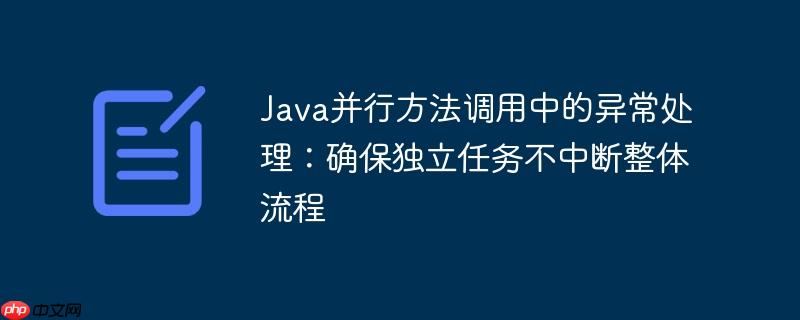
在现代软件开发中,为了提高系统吞吐量和响应速度,并行处理已成为常用技术。然而,当多个任务并发执行时,如何优雅地处理其中某个任务抛出的异常,同时不中断其他任务的正常执行,是一个常见且关键的挑战。传统上,如果一个线程或任务抛出未捕获的异常,它可能会导致整个进程或批处理操作中止,这在需要处理大量独立单元(如批量数据处理、多服务调用)的场景中是不可接受的。例如,在一个需要并行禁用多个系统组件的场景中,我们希望即使某个组件禁用失败,也不影响其他组件的禁用尝试。
Java 8引入的流API和CompletableFuture极大地简化了并行编程。然而,在使用这些工具时,如果不当处理异常,仍可能遇到中断整体流程的问题。例如,当使用Stream.parallel().forEach()并尝试在内部通过CompletableFuture.complete(e)立即传播异常时,forEach的语义可能导致一旦有异常发生,整个流操作就会提前终止,而不等待所有并行任务的完成。这意味着其他尚未执行或正在执行的任务可能被中断,无法达到我们期望的“即使部分失败,整体也继续”的目标。
核心思想是,将每个并行任务的执行结果(包括成功的数据或发生的异常)封装起来,而不是让异常立即向上抛出并中断流程。这意味着每个任务在其内部捕获并处理自己的异常,然后将异常作为其“结果”的一部分返回。最终,所有任务完成后,我们可以统一收集并检查每个任务的执行结果,包括哪些任务成功,哪些任务失败以及失败的原因。
CompletableFuture 结合 ExecutorService 提供了对并行任务执行和结果收集的强大控制。这种方法允许我们自定义线程池,并灵活地处理每个异步任务的成功或失败状态。
实现步骤:
立即学习“Java免费学习笔记(深入)”;
示例代码:
import java.util.ArrayList;
import java.util.List;
import java.util.concurrent.CompletableFuture;
import java.util.concurrent.ExecutorService;
import java.util.concurrent.Executors;
import java.util.concurrent.TimeUnit;
import java.util.stream.Collectors;
// 模拟 UnSubscribeRequest 类
class UnSubscribeRequest {
private Long id;
private String requestedBy;
private String cancellationReason;
// 构造器和Builder模式简化创建
private UnSubscribeRequest(Builder builder) {
this.id = builder.id;
this.requestedBy = builder.requestedBy;
this.cancellationReason = builder.cancellationReason;
}
public Long getId() { return id; }
public String getRequestedBy() { return requestedBy; }
public String getCancellationReason() { return cancellationReason; }
public static Builder unsubscriptionRequest() {
return new Builder();
}
public static class Builder {
private Long id;
private String requestedBy;
private String cancellationReason;
public Builder id(Long id) { this.id = id; return this; }
public Builder requestedBy(String requestedBy) { this.requestedBy = requestedBy; return this; }
public Builder cancellationReason(String cancellationReason) { this.cancellationReason = cancellationReason; return this; }
public UnSubscribeRequest build() { return new UnSubscribeRequest(this); }
}
}
// 封装任务执行结果的类
class TaskOutcome {
private final Long id;
private final boolean success;
private final Exception exception;
private final String message;
public static TaskOutcome success(Long id, String message) {
return new TaskOutcome(id, true, null, message);
}
public static TaskOutcome failure(Long id, Exception exception) {
return new TaskOutcome(id, false, exception, exception.getMessage());
}
private TaskOutcome(Long id, boolean success, Exception exception, String message) {
this.id = id;
this.success = success;
this.exception = exception;
this.message = message;
}
public Long getId() { return id; }
public boolean isSuccess() { return success; }
public Exception getException() { return exception; }
public String getMessage() { return message; }
@Override
public String toString() {
return "TaskOutcome{" +
"id=" + id +
", success=" + success +
", message='" + message + '\'' +
(exception != null ? ", exceptionType=" + exception.getClass().getSimpleName() : "") +
'}';
}
}
// 模拟日志工具
class Logger {
public void error(String format, Object... args) { System.err.printf("[ERROR] " + format + "%n", args); }
public void info(String format, Object... args) { System.out.printf("[INFO] " + format + "%n", args); }
}
public class ParallelMethodExecutor {
private static final Logger log = new Logger();
// 模拟原始的 disablePackXYZ 方法,可能抛出异常
private static void disablePackXYZ(UnSubscribeRequest request) throws Exception {
Long id = request.getId();
if (id % 2 != 0) { // 模拟奇数ID禁用失败
throw new RuntimeException("Simulated failure for ID: " + id);
}
// 模拟耗时操作
Thread.sleep(50);
log.info("Successfully disabled pack for ID: %d", id);
}
/**
* 并行执行禁用操作,确保单个任务失败不中断整体流程。
* @param rId 请求ID
* @param disableIds 待禁用的ID列表
* @param requestedBy 请求者
*/
public static void executeParallelDisable(Long rId, List<Long> disableIds, String requestedBy) {
// 创建固定大小的线程池,通常建议根据CPU核心数和任务类型(IO密集/CPU密集)来设定
// 这里使用10个线程,但实际应用中应根据负载调整
ExecutorService executor = Executors.newFixedThreadPool(Math.min(disableIds.size(), 10));
List<CompletableFuture<TaskOutcome>> futures = disableIds.stream()
.map(disableId -> CompletableFuture.supplyAsync(() -> {
try {
// 调用实际的业务方法
disablePackXYZ(UnSubscribeRequest.unsubscriptionRequest()
.requestedBy(requestedBy)
.cancellationReason("system")
.id(disableId)
.build());
return TaskOutcome.success(disableId, "Pack disabled successfully.");
} catch (Exception e) {
// 捕获异常,并将其封装到 TaskOutcome 中返回
log.error("Failed to disable pack. id: %d, rId: %d. Error: %s", disableId, rId, e.getMessage());
return TaskOutcome.failure(disableId, e);
}
}, executor)) // 指定使用自定义的线程池
.collect(Collectors.toList());
// 等待所有 CompletableFuture 完成。
// allOf() 不会抛出单个任务的异常,它只会在所有任务都完成(无论成功或失败)后返回一个 CompletableFuture<Void>。
CompletableFuture<Void> allOf = CompletableFuture.allOf(futures.toArray(new CompletableFuture[0]));
try {
allOf.join(); // 阻塞等待所有任务完成。如果单个任务内部已捕获异常,这里不会抛出。
} catch (Exception e) {
// 只有当 allOf 本身出现问题(如编程错误)时,才会进入此catch块
log.error("An unexpected error occurred while waiting for all tasks: %s", e.getMessage());
} finally {
// 确保线程池被关闭
executor.shutdown();
try {
if (!executor.awaitTermination(60, TimeUnit.SECONDS)) { // 等待60秒
executor.shutdownNow(); // 强制关闭
}
} catch (InterruptedException ex) {
executor.shutdownNow();
Thread.currentThread().interrupt(); // 恢复中断状态
}
}
// 收集以上就是Java并行方法调用中的异常处理:确保独立任务不中断整体流程的详细内容,更多请关注php中文网其它相关文章!

每个人都需要一台速度更快、更稳定的 PC。随着时间的推移,垃圾文件、旧注册表数据和不必要的后台进程会占用资源并降低性能。幸运的是,许多工具可以让 Windows 保持平稳运行。




Copyright 2014-2025 https://www.php.cn/ All Rights Reserved | php.cn | 湘ICP备2023035733号